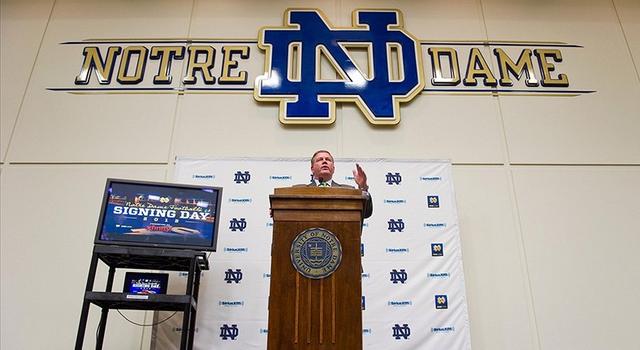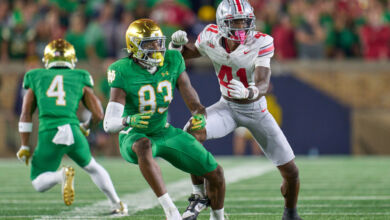

When I first joined a friend’s online dynasty in the popular video game NCAA ’13 as Arizona State, even as a rookie my first priority was abundantly clear: if I desired to seriously compete against more veteran players, I needed to get better talent. With that in mind I set out to create an effective recruiting strategy. In the video game, recruiting pipelines give you an extra bonus when recruiting a player, making it easier to gain their signature and ultimately their services. And in order to establish a pipeline in a given state, the game requires you have at least four players on your roster from the state in question.
Examining my recruiting board as the head man at Arizona State, I noticed I had pipelines locked down in California, Colorado and Arizona, which was a good start. But, to get to the next level and be a serious contender, I needed a foothold in a nearby state with the richest talent: Texas. Over the course of a few seasons I intentionally let my pipeline in Colorado lapse and targeted enough recruits for a foundation and pipeline in Texas, and eventually, after several successful years, Florida. Pulling in talent from California, Texas and Florida, in addition to the very best in Arizona, has allowed me to snag a few championships in my league with my friends, but it also has offered a rudimentary and simplistic look at how college programs operate when recruiting. The process made me wonder: what areas have Brian Kelly and staff been targeting the most, and how are their strategy and results similar or dissimilar from how Tyrone Willingham or Charlie Weis operated?
To answer these questions, I went through the recruiting classes of each coach and recorded each player’s state. This method offers a fairly clear picture of what region Willingham, Weis and Kelly targeted for talent, though a few drawbacks are worth mentioning. I included each recruiting class as signed, meaning eventual transfers (for example, Gunner Kiel) are still counted. And while there are still potentially misleading hiccups – signing a kicker from Florida still counts as one player, though a kicker from the Sunshine State isn’t on the same power level as a defensive linemen from Florida – overall the list below offers good insight into each coach’s priorities.
| Tyrone Willingham | Charlie Weis | Brian Kelly |
| Recruiting Classes ’02-‘04 | Recruiting Classes ’05-‘09 | Recruiting Classes ’10-‘14 |
| California (9) | Florida (10) | Ohio (13) |
| Pennsylvania (6) | Illinois (10) | Florida (11) |
| New Jersey (5) | California (9) | California (8) |
| Minnesota (4) | Ohio (9) | Indiana (8) |
| Illinois (3) | Indiana (8) | Texas (6) |
| Maryland (3) | Pennsylvania (8) | Illinois (5) |
| Michigan (3) | New Jersey (6) | New Jersey (4) |
| Ohio (3) | Georgia (4) | North Carolina (4) |
| Texas (3) | Texas (4) | Georgia (3) |
| Alabama (2) | Connecticut (3) | Kentucky (3) |
| Florida (2) | Michigan (3) | Pennsylvania (3) |
| Georgia (2) | Minnesota (3) | Virginia (3) |
| Virginia (2) | Missouri (3) | Arizona (2) |
| Arizona (1) | North Carolina (3) | Michigan (2) |
| Connecticut (1) | Oklahoma (3) | New York (2) |
| Indiana (1) | Tennessee (3) | South Carolina (2) |
| Iowa (1) | Hawaii (2) | Colorado (1) |
| Kentucky (1) | Kentucky (2) | Connecticut (1) |
| Massachusetts (1) | Nevada (2) | Hawaii (1) |
| Tennessee (1) | Virginia (2) | Massachusetts (1) |
| Arkansas (1) | Minnesota (1) | |
| Kansas (1) | Nevada (1) | |
| Maryland (1) | New Mexico (1) | |
| Massachusetts (1) | Utah (1) | |
| Nebraska (1) | Washington D.C. (1) | |
| Oregon (1) | Washington (1) | |
| South Carolina (1) |
This comprehensive list illustrates rather well the wide net Notre Dame wields in its recruiting efforts, but also reflects interesting trends. Tyrone Willingham signed two players from Alabama, something that seems almost incomprehensible now. Charlie Weis managed to sign several players from Oklahoma, Nebraska, Kansas and Missouri, an area of the nation not normally considered fertile ground for the Fighting Irish. And Brian Kelly has been pushing hard to get Arizona on the Notre Dame radar. While only one player from Arizona was signed under the Willingham and Weis eras, Kelly has signed two players from The Grand Canyon State and is battling for more. In the Class of 2013 Notre Dame signed Arizona native Cole Luke and fought for another coveted recruit, Priest Willis. This recruiting cycle Kelly is already pushing for a quarterback/wide receiver tandem hailing from Scottsdale, AZ.
While the big picture provides interesting insight, the true meat of recruiting intent is deciphered at the top level.
| Tyrone Willingham | Charlie Weis | Brian Kelly |
| Recruiting Classes ’02-‘04 | Recruiting Classes ’05-‘09 | Recruiting Classes ’10-‘14 |
| California (9) | Florida (10) | Ohio (13) |
| Pennsylvania (6) | Illinois (10) | Florida (11) |
| New Jersey (5) | California (9) | California (8) |
| Minnesota (4) | Ohio (9) | Indiana (8) |
| IL/MD/MI/OH/TX (3) | Indiana/Pennsylvania (8) | Texas (6) |
| Players from SEC States: 8 | Players from SEC States: 21 | Players from SEC States: 26 |
High school football is not created equal, and the traditional powers, such as California, Florida, Texas and Ohio, must be at the top of Notre Dame’s list if the Irish are to continue their upward trend. While Willingham recruited California well, Ohio and Texas were barely covered, and Florida was nowhere to be found.
Charlie Weis began to turn the recruiting tide in ND’s favor. Florida was at the top of his recruiting list and Notre Dame’s presence in Ohio grew, all while maintaining a heavy presence in California. However, despite vastly significant strides compared to the Willingham years, the Weis-led Fighting Irish had difficulty with a Southern breakthrough outside of Florida’s boundaries.
If Notre Dame’s undefeated regular season record in 2012 seemed unexpected, one look at Kelly’s recruiting areas should help with the explanation. Ohio: check. Florida: check. California: check. Texas: check. All made appearances in Kelly’s top five, as well as breaking ground in other Southern areas, like the Carolinas and Georgia. The South is where power is concentrated in college football, and Brian Kelly and Notre Dame are doing an excellent job of increasing the program’s exposure below the Mason-Dixon line. A new affiliation with the ACC, with member states scattered all over the South, will only aid Notre Dame’s Southern expansion efforts.
These graphs highlight Kelly’s efforts to establish pipelines in every traditional high school recruiting power, including Texas, which remained elusive even under Charlie Weis’ watch. If these trends continue, Notre Dame will firmly entrench itself as a consistent college football power once again.




Thank you for the kind words. It was fun digging this information up. Recruiting is going better than I expected.
A giant is about to awaken, as all the scoffers are asleep and that giant is NOTRE DAME FIGHTING IRISH football! If we the fans will just be patient we will see our team rise to the top. We are so close it isn’t funny. time and talent. I see a national championship in 2014\2015. You will notice I did not include 2013. new players need time to mesh per say on and off the field. And I know their will be the doubters, but I believe we are about to see an eruption for the good of porgram. Those on the outside will be silenced while we SHOUT in EXCITEMENT for a football program the BEST in the nation. Gog Bless coach Kelly, the players, the Fans and our GREAT NATION irish fan FOREVER, JIM
First rate analysis. Data trumps emotion and anecdotalism.
They keep pounding in the SEC turf. Corey Holmes was up last weekend, and now it looks like Lorenzo Carter is listening to Booker and will get
up to South Bend.
And they show guts because after the Shepard/Greenberry travail of 2012, they kept right at it and wound up with Redfield and Vanderdoes.
I hope you update this analysis annually.